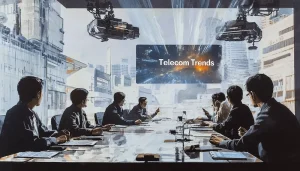“Network providers are still working on the infrastructure and installation of 5G,
but, once ready, it will vastly optimize the way we use mobile networks.”

Let us start by saying that 5G technology is still going to be transformative. There’s no denying that. But the rollout of 5G technology hasn’t exactly gone according to plan. First of all, what is it?
What Is 5G? And What Does It Offer?
As its name suggests, 5G is the fifth generation of the wireless mobile network that provides Internet connectivity to devices and users around the globe. You will likely use it on your smartphone someday.
The newest generation of this mobile network is known as 5G, and it’s starting to see initial phases of adoption by smartphones, tablets, and other mobile devices. But what is 5G? And is it truly a breakthrough in global connectivity?
In a past blog post, we talked extensively about the huge potential of the 5G cellular network compared to the standard 4g and called it “the new global standard.”
In addition to mobile broadband that most consumers will be familiar with, there are many other applications of 5G. For instance, it can be implemented with Internet of Things (IoT) networks to connect multiple devices, machines, and sensors together for more complex data collection operations.

To make the signal clearer and more accessible to more people, 5G uses several underlying technologies:
The result of all these new tools working together is that 5G is more flexible and capable than ever before, and only time will tell how many new use cases will be found for it. Large-scale implementations of IoT and more mission-critical communications will soon be possible with 5G.
5G technology is considered superior to 4G for several key reasons:
Previous “Gs,” while less powerful, were stepping stones that led to this innovative new breakthrough. 1G can be described as analog voice, which was first transmitted this way in the 1980s. 2G followed about a decade later and started transferring digital audio.
3G was the beginning of mobile data as we know it back in the early 2000s, and it was such a breakthrough that Apple even named its feature product, the iPhone 3G, after the network it was compatible with.
From there, 4G LTE in the 2010s was an even faster, more capable online network that most smartphones today operate on. You’ve likely never had any problems watching YouTube videos or movies on a mobile device if you had a 4G LTE connection.
As far as businesses are concerned, 5G will create a new type of network that can connect virtually everything together, including machines, devices, and people. 5G delivers higher peak data speeds, more reliability, and better accessibility compared to 4G. The specific benefits are:
“Network providers are still working on the infrastructure and installation of 5G,
but, once ready, it will vastly optimize the way we use mobile networks.”
Both individuals and businesses will reap the benefits of faster browsing and download speeds, as well as lower latencies and a much larger capacity for more users.
Whether you’re an AI enthusiast, an online shopper ready for e-commerce implementations of augmented reality, or just a multiplayer gamer excited for virtual reality, there are many reasons to look forward to 5G.
For society as a whole, 5G will have immense implications for economic development. Let’s look at what the current studies show about the imminent impact of 5G’s rollout.
Two reports we’re looking at here are the 2020 report from IHS Markit and the 2021 Accenture reports for both the United States and Europe.
In terms of overall financial growth, we’re expecting by 2035 that $13.1 trillion worth of sales will be enabled partly by 5G technology.
22.8 million new jobs will also be created thanks to the network. GDP will grow by 10.8%, a rate of $265 billion annually, over the next 15 years.
Many industries will also see a major boost in activity thanks to 5G:
These are just a few examples of industries that will benefit from 5G rollout. In fact, experts predict that entirely new markets will pop up as well. Cities, for instance, might start implementing more efficient infrastructure and safety features enabled by IoT.
And on top of all these changes, 5G is a huge step in the right direction for sustainability because it introduces new methods of cutting down on carbon emissions and boosting energy efficiency.
More optimized transportation routes will result in less gasoline usage in cars, and agricultural applications of 5G will enable reduced herbicide and pesticide usage.
We can’t talk about 5G technology without at least mentioning the conspiracies behind it. Many people claim that wireless technology causes hidden health problems in humans and can even contribute to the spread of COVID-19.
While studies have shown that radio-frequency radiation is a risk, there is no concrete proof that 5G specifically will be a significant problem for most of us.

You might hear about 5G technology in the context of smartphone mobile data connections, but it goes beyond that application.
How will specific industries react to these changes? Many experts already have new methodologies planned in a 5G-enabled market.
The stronger Quality of Service (QoS) of 5G is what companies should be most interested in. Technologies and trends that were unfeasible with earlier networks are now on the table, and the various startups and businesses can’t wait to jump on the bandwagon.
The result is unparalleled new potential for various industries everywhere, such as healthcare, logistics, transportation, manufacturing, and anything else in between. Remote work, which has seen an immense spike in popularity, will be empowered by 5G connectivity.
This last point is important because it’s one of the largest evolutions compared to 4G. 5G can cover various spectrum types (licensed or unlicensed) and cover many bands (low to high). Connection methods can be between devices or through a multi-hop mesh.
5G is hitting the scene at the perfect time to empower the rising trend of remote work and closer online collaboration amongst employees and teams.
But only the companies with a serious approach to business communication will gain access to these benefits.
Forward-thinking management groups know that cloud communication is the key to keeping your company afloat in an ever-competitive corporate landscape.
Find out how major brands like Mitel, Digium, and Metaswitch have empowered their teams to use these technologies through softphone platforms like Cloud Softphone.
While no one corporation owns the entirety of 5G, several groups have arisen in order to help manage its rollout.
The 3rd Generation Partnership Project (3GPP) is the standards organization responsible for global specifications for 3G, 4G, LTE, and 5G.
It also supported the development of 5G’s underlying technologies like the air interface.

What should telecommunications providers do both now and in the future? That’s the question industry all industry professionals are asking. With so much set to change in 2025 — you’ll want to follow these top telecom trends. Here’s where we see the industry going in 2025, including top trends, challenges, and innovations. 1. Artificial Intelligence […]

5G isn’t that far away anymore. Mass adoption throught the globe is already a thing, In the third quarter of 2023 alone, Ericsson reported that 5G subscriptions with a 5G-capable device grew by 163 million to reach approximately 1.4 billion globally. International Data Corp’s. (IDC) “U.S. 5G Smartphone Forecast, 2023-2027” forecasts that by 2027, 155.0 […]

Remember when 4G launched and everyone said it’d change the way we communicate? You know, that same technology CNN proclaimed would “change your life.” In many ways, 4G did change the way we communicate. It made smartphones more accessible and laid the foundation for the many communication methods we still use today. Well, times are […]